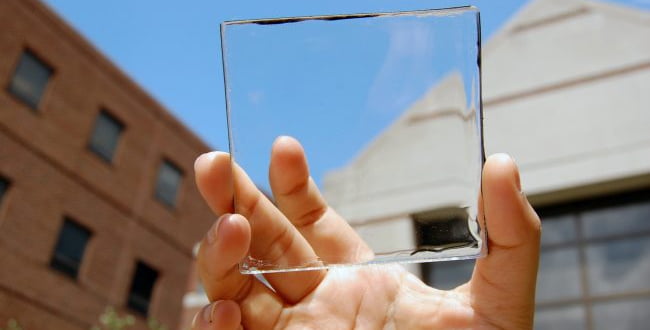
By Ana Cosma,
The team focused on the see-through factor, so they developed a transparent luminescent solar concentrator, or TLSC, which can be placed over a clear surface like a window. It can harvest solar energy without affecting the transmittance of light.
The technology uses organic molecules which absorb light wavelengths which are not visible to the human eye, such as infrared and ultraviolet light. Richard Lunt, assistant professor of chemical engineering and materials science at MSU’s College of Engineering, says:
“We can tune these materials to pick up just the ultraviolet and the near infrared wavelengths that then ‘glow’ at another wavelength in the infrared. The captured light is transported to the contour of the panel, where it is converted to electricity with the help of thin strips of photovoltaic solar cells.”

“We can tune these materials to pick up just the ultraviolet and the near infrared wavelengths that then ‘glow’ at another wavelength in the infrared” – Richard Lunt, assistant professor of chemical engineering and materials science at MSU’s College of Engineering. The captured light is transported to the contour of the panel, where it is converted to electricity with the help of thin strips of photovoltaic solar cells.

This development would make the most out of the buildings’ facades, since the vertical footprint is often larger than the rooftop one – especially for glass towers. Solar harvesting of Transparent Solar Panels would, thus, become more efficient and aesthetically, without altering the architectural design. Moreover, this technology could be easily integrated in old buildings.
Currently the team is working on improving the energy-producing efficiency, that is of 1 % at the moment. The aim is to reach an efficiency beyond 5%. As aforementioned, if developments work, applications would be countless. Members of MSU’s research team include Yimu Zhao, Benjamin Levine and Garrett Meek.
According to the New York Times:
“If the cells can be made long-lasting, they could be integrated into windows relatively cheaply, as much of the cost of conventional photovoltaics is not from the solar cell itself, but the materials it is mounted on, like aluminum and glass. Coating existing structures with solar cells would eliminate some of this material cost.
If the transparent cells ultimately prove commercially viable, the power they generate could significantly offset the energy use of large buildings, said Dr. Lunt, who will begin teaching at Michigan State University this fall.
“We’re not saying we could power the whole building, but we are talking about a significant amount of energy, enough for things like lighting and powering everyday electronics,” he said.”
Further research has been funded by the Center for Excitonics, an Energy Frontier Research Center financed by the Department of Energy.
Source: www.arch2o.com
Disclaimer: We at Prepare for Change (PFC) bring you information that is not offered by the mainstream news, and therefore may seem controversial. The opinions, views, statements, and/or information we present are not necessarily promoted, endorsed, espoused, or agreed to by Prepare for Change, its leadership Council, members, those who work with PFC, or those who read its content. However, they are hopefully provocative. Please use discernment! Use logical thinking, your own intuition and your own connection with Source, Spirit and Natural Laws to help you determine what is true and what is not. By sharing information and seeding dialogue, it is our goal to raise consciousness and awareness of higher truths to free us from enslavement of the matrix in this material realm.
 EN
EN FR
FR


























I am curious if there is or will be a residential component to this? And if so is there any trials that are available to get in on.